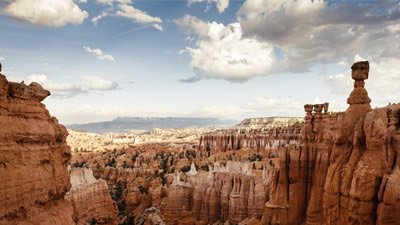
Creation Road Trip: More Destinations
If you’re planning an outing to one of these locations, be sure to read the following biblical explanations of how catastrophic processes formed these amazing sights during Noah’s Flood.
Devils Tower
Towering above the flat landscape of Wyoming is one of the natural wonders of the world. Standing almost 1,300 feet (395 m) above the Belle Fourche River, Devils Tower is enjoyed by thousands of visitors each year and provides a challenge for any adventurous rock-climber. Devils Tower, an impressive formation amid a relatively flat region, raises natural questions among many viewers as to how and when it formed.
Devils Tower was formed when magma (molten volcanic rock inside the earth) was pushed into place underground. At this time, the surface of the surrounding land was nearly 3,000 feet higher than it is today. After the magma hardened and cooled, the area was then eroded away.
Devils Tower is made up of spectacular vertical columns of igneous rock with five or six sides each. At the base, these columns are about seven feet wide, and they decrease in size to around four feet at their peak. As hot magma cools and solidifies, it shrinks in volume and fractures along vertical planes, which explains how these columns formed.
Evolutionary geologists believe that Devils Tower was formed underground about 40 million years ago. Through the millions of years that followed, the land was slowly eroded away by the retreating and returning of seas, which took place over these vast ages, slowly exposing more and more of Devils Tower.
Biblical geologists have a different explanation for the formation of Devils Tower—one that fits the facts well: One catastrophic event was responsible for the formation of this natural wonder. This event was the Genesis Flood about 4,500 years ago, as recorded in Genesis 6–9.
There is evidence that dramatic volcanic activity accompanied the Flood, and this would explain the intrusion of magma that initially formed Devils Tower underground. It is also likely that at that time the earth was dramatically changed as the crust of the earth shifted, causing new ocean basins to sink and continents to rise. After the ocean basins began sinking, the floodwaters began to drain from the land surface. Initially, rapid erosion of sediments would have occurred in wide spans, cutting wide, flat surfaces across the landscapes. Eventually, the receding waters split into large channels which cut deep valleys and, in this instance, formed the valley of the Belle Fourche River, thus exposing Devils Tower.
See this awesome formation that is a testament to the eroding force of Noah’s Flood.
Uluru (Ayers Rock)
One of Australia’s most famous landmarks stands tall against the flat desert region of the “Red Center” of the Northern Territory. More than 400,000 visitors each year come to Uluru, also known as Ayers Rock. It is a monolith, like a huge boulder, that rises over 1,100 feet (340 m) above the desert plain, measures almost six miles (9.6 km) around its base and covers an area of over two square miles (3.2 km2).
Evolutionary timescales for the formation of Uluru span hundreds of millions of years of floods, deposition and tectonic activity. However, Looking at the evidence found in Uluru from a biblical perspective, we see that this wonderful formation did not result from millions of years of local flooding, erosion and tectonic activity. Rather, it was formed catastrophically by one major event and its after-effects—the Flood of Noah’s day.
The global Flood described in Genesis 6–8 generated the precise conditions to tear up, transport and deposit the nearly 20,000 feet (6,000 m) of sediment that now make up this formation as layers of jagged, mixed-sized grains. The tectonic activity that ended the global Flood was responsible for the tilting and uplifting of the hardened layers we see at Uluru today. After this uplift, the landscape dried out, turning it into today’s surrounding desert.
Enjoy the impressive beauty of Uluru, and don’t forget that this amazing formation gives evidence of the Genesis Flood.
White Cliffs of Dover
Impressive and dramatic, the White Cliffs of Dover keep watch as a citadel over the southern entrance into the Strait of Dover, which separates England from France. These towering escarpments, stretching 10 miles (16 km) along the coast, not only once guarded England from its enemies but, more importantly, they now give tribute to the global Flood as described in Genesis 6–9.
Many secular geologists claim that these chalk beds speak of an old earth since they believe chalk formed slowly and progressively over millions of years. However, when we interpret the evidence from a biblical perspective, we see that there is an explanation for the formation of these chalk beds that aligns with the biblical timescale of thousands of years. The main cause of these beds is the catastrophic, worldwide Flood.
The white chalk of these cliffs is composed almost entirely of calcium carbonate. This calcium carbonate, a very pure type of limestone, consists of billions of microorganisms that today live in the upper 300–600 feet (90–180 m) of the open seas. When these microorganisms die, their calcium-rich shells accumulate on the bottom of the ocean floor. These shells cover about one-quarter of the surface of the earth today.
The measured rate of chalk accumulation today seems to demonstrate that these chalk beds could not have formed quickly. Evolutionists claim that these chalk beds were formed around 70 to 100 million years ago, during the “Cretaceous period,” when the southern portion of England was submerged by a shallow tropical sea.
However, under the right conditions, rapid production and accumulation of these microorganisms on the ocean floor is possible. These conditions include turbulent waters, high winds, decaying fish, increased temperature and nutrients from volcanic waters and other sources. With catastrophic volcanic activity warming the oceans and releasing large amounts of CO2, and with the torrential rains and the churning and mixing of fresh and salt waters, the Flood of Noah’s day produced the right conditions for a “blooming” production of micro-organisms and the chalk’s rapid accumulation.
Thus, the White Cliffs of Dover confirm the biblical account of a global Flood just over 4,000 years ago. The evidence is apparent when viewed through a biblical perspective.
Giant’s Causeway
Giant’s Causeway, with its unusual formations, attracts thousands of visitors each year to Northern Ireland. Some geologists claim that the Causeway was formed over 60 million years ago by intermittent periods of volcanic activity. But other geologists, who approach Giant’s Causeway with a biblical understanding of the past, state that this wonder was formed around 4,500 years ago as a result of a single, great catastrophe.
The Causeway basalts are made up of seven separate lava flows and vary in height from 330 feet (100 m) down to the water’s edge. These layers were produced as a result of the earth’s plates shifting. These movements created great openings in the earth’s crust, through which lava rushed out and covered the land. This intermittent tectonic activity generated the different layers of lava that are found in this area. Each layer of lava was hardened by water before being covered by another layer. The 40,000 or more, mostly six-sided, columns of Giant’s Causeway give evidence to this cooling. The columns formed as the lava began to cool from both the top and bottom of the lava pool. As these surfaces hardened, they contracted, creating deep cracks all along the surface of the lava pool. The lava then continued to cool and contract which, in turn, extended the cracks vertically until they finally connected, forming columns.
Evolutionary geologists have attempted to date rocks found in Giant’s Causeway by using a process called radiometric dating, and have obtained a date of about 60 million years. However, radiometric dating is known to be flawed and is based on many unproved assumption. One catastrophic event that gives more evidence to this faulty dating process is the explosion of Mount St. Helens in the northwestern USA. When rock that was formed from that eruption was tested, the results yielded “dates” up to several million years, when in reality the rock was just twenty years old.
The conditions of the Flood described in the Bible provide an explanation for the formation of Giant’s Causeway. Several months into Noah’s Flood, the sedimentary strata now found in Northern Ireland had been deposited by the violent currents of the Flood waters. Then late in the Flood, as the waters began receding, volcanic activity covered the sedimentary strata with thin layers of lava. This lava then hardened as it cooled. As the tectonic activity paused, the waters briefly covered the area again, depositing floating mats of vegetation and other sediment on the lava surface. Within days, the tectonic activity continued, resulting in the layers of lava and sediment being covered with another layer of lava. This rapid cycle of volcanic and tectonic activity with water surges resulted in the columns and cliffs we see in Giant’s Causeway today.
Scientists who accept the biblical record date the Genesis Flood to about 4,500 years ago, rather than believing the millions of years determined by the faulty radiometric dating methods. Giant’s Causeway stands as a testimony to a time when God judged the wickedness of mankind, but protected those on the Ark who obeyed Him.
Petrified Forests of Yellowstone
Yellowstone National Park, America’s first National Park, includes over two million acres and covers parts of three states—Montana, Wyoming and Idaho. Its natural beauty and unique features continue to impress even the most frequent visitor. Once an active volcano, Yellowstone is now well known for its diverse wildlife, boiling mud pots and numerous geysers and hot springs. In addition to its pristine beauty and natural features, Yellowstone is also known for some very unique forests—forests made of stone.
The petrified forests in Yellowstone were revealed when the edge of a cliff eroded, leaving many layers of stone trees visible. At Specimen Ridge and Specimen Creek, there are between 27 and 50 layers of petrified trees. These petrified trees formed through a process called permineralization, which occurs when the pores of the tree are filled by minerals from silica-rich water.
Evolutionists explain the petrified forests of Yellowstone as the result of an ongoing cycle:
- A forest grows and then is buried by volcanic ash and other debris.
- Dissolved minerals are soaked up by the trees, petrifying them.
- The ash weathers into clay and soil.
- A new forest grows on top of the previous one, which is subsequently buried by volcanic ash to begin the process again. This process would have occurred numerous times to produce the multiple layers of petrified forests found here at Yellowstone, estimated to have taken over 30,000 years.
Biblical creationists explain these forests in a different way. The evidence points to catastrophic processes, which are consistent with the Bible's teaching of creation about 6,000 years ago and a worldwide Flood. The petrified forests of Yellowstone actually are the result of catastrophic burial during the Genesis Flood, which with its associated catastrophic volcanic activity, would have produced the right conditions for these trees to have been rapidly deposited and then to have been petrified quickly.
Several lines of evidence give support to this view. First, these trees (as well as the soils) give evidence that they were uprooted and transported from one location to another, most likely by water. Second, they show evidence of rapid burial—there is insufficient clay and organic soil in the successive layers for the growth of new trees as would be required under the evolutionary view. The evidence itself speaks of a rapid sequence of deposition and burial in a catastrophic event, not of thousands of years of slow growth, burial and regrowth.
Yellowstone National Park, where many natural wonders are remarkably preserved, also preserves a testament to the catastrophic Genesis Flood and its after-effects.
Recommended Resources

Answers in Genesis is an apologetics ministry, dedicated to helping Christians defend their faith and proclaim the good news of Jesus Christ.
- Customer Service 800.778.3390
- © 2024 Answers in Genesis






